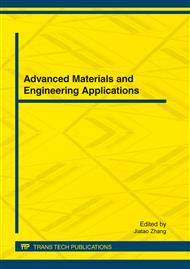[1]
M.A. Ghanem, Electrocatalytic activity and simultaneous determination of catechol and hydroquinone at mesoporous platinum electroden, Electrochemistry Communications. 9 (2007) 2501-2506.
DOI: 10.1016/j.elecom.2007.07.023
Google Scholar
[2]
L. Wang, P.F. Huang, J.Y. Bai, H.J. Wang, LY Zhang, Y.Q. Zhao, Covalent modification of a glassy carbon electrode with penicillamine for simultaneous determination of hydroquinone and catechol , Microchimica Acta.158 (2007) 151-157.
DOI: 10.1007/s00604-006-0703-x
Google Scholar
[3]
L. Su, L.Q. Mao, Gold nanoparticle/alkanedithiol conductive films selfassembled onto gold electrode: electrochemistry and electroanalytical application for voltammetric determination of trace amount of catechol, Talanta.70 (2006) 68-74.
DOI: 10.1016/j.talanta.2006.01.015
Google Scholar
[4]
H.G. Lin, T. Gan, K.B. Wu, Sensitive and rapid determination of catechol in tea samples using mesoporous Al-doped silica modified electrode, Food Chemistry. 113 (2009) 701-704.
DOI: 10.1016/j.foodchem.2008.07.073
Google Scholar
[5]
K.S. Novoselov, A.K. Geim, S.V. Morozov, D. Jiang, Y. Zhang, S.V. Dubonos, I.V. Grigorie -va, A.A. Firsov, Electric field effect in atomically thin carbon films, Science. 306 (2004) 666-669.
DOI: 10.1126/science.1102896
Google Scholar
[6]
Y.B. Zhang, Y.W. Tan, H.L. Stormer, P. Kim, Experimental observation of the quantum Hall effect and Berry's phase in graphene, Nature. 438 (2005) 201-204.
DOI: 10.1038/nature04235
Google Scholar
[7]
X.H. Kang, J. Wang, H. Wu, J. Liu, I.A. Aksay, Y.H. Lin, A graphene-based electrochemical sensor for sensitive detection of paracetamol,Talanta. 51 (2010) 754-759.
DOI: 10.1016/j.talanta.2010.01.009
Google Scholar
[8]
F.H. Li, J. Chai, H.F. Yang, D.X. Han, L. Niu, Synthesis of Pt/ionic liquid/graphene nanocomposite and its simultaneous determination of ascorbic acid and dopamine, Talanta. 81 (2010) 1063-1068.
DOI: 10.1016/j.talanta.2010.01.061
Google Scholar
[9]
W.S. Hummers, JR, R.E. Offeman, Preparation of Graphitic Oxide, J. Am. Chem. Soc. 80 (1958) 1339-1341.
DOI: 10.1021/ja01539a017
Google Scholar
[10]
Y.C. Si, E.T. Samulski, Synthesis of Water Soluble Graphene, Nano. Lett. 8 (2008) 1679-1682.
DOI: 10.1021/nl080604h
Google Scholar
[11]
A.B. Bourlinos, D. Goumis, D. Petridis, T. Szabo, A .Szeri, I .Dekany, Graphite oxide: Chemical reduction to graphite and surface modifcation with primary aliphatic amines and amino acids, Langmuir.19 (2003) 6050-6055.
DOI: 10.1021/la026525h
Google Scholar



